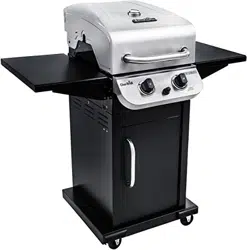Documents: Go to download!
- Owner's manual - (English, French, Spanish)
- USE AND CARE
- GRILLING GUIDE - Getting Started
- GRILLING GUIDE – Cleaning Your Grill
- Troubleshooting
- PARTS DIAGRAM
Table of contents
User manual Grill
USE AND CARE
LP Cylinder Removal, Transport and Storage
•Turn OFF all control knobs and LP cylinder valve. Turn coupling nut counterclockwise by hand only - do not use tools to disconnect. Loosen cylinder screw beneath bottom shelf or disconnect other retention means, then lift LP cylinder up and and out of cart. Install safety cap onto LP cylinder valve. Always use cap and strap supplied with valve. Failure to use safety cap as directed may result in serious personal injury and/or property damage.
•A disconnected LP cylinder in storage or being transported must have a safety cap installed (as shown). Do not store an LP cylinder in enclosed spaces such as a carport, garage, porch, covered patio or other building. Never leave an LP cylinder inside a vehicle which may become overheated by the sun.
•Do not store an LP cylinder in an area where children play.
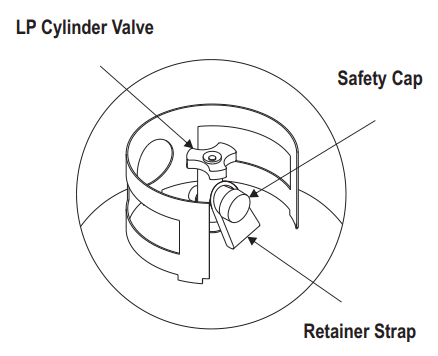
LP Cylinder
- The LP cylinder used with your grill must meet the following requirements:
- Use LP cylinders only with these required measurements: 12" (30.5cm) (diameter) x 18" (45.7 cm) (tall) with 20 lb. (9 kg.) capacity maximum.
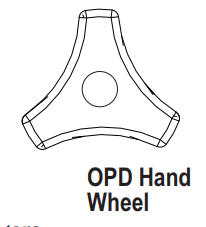
- LP cylinders must be constructed and marked in accordance with specifications for LP cylinders of the U.S. Department of Transportation (DOT) or for Canada, CAN/CSA-B339, cylinders, spheres and tubes for transportation of dangerous goods, Transport Canada (TC). See LP cylinder collar for marking.
- LP cylinder valve must have:
- Type 1 outlet compatible with regulator or grill.
- Safety relief valve.
- UL listed Overfill Protection Device (OPD). This OPD safety feature is identified by a unique triangular hand wheel. Use only LP cylinders equipped with this type of valve.
- LP cylinder must be upright for vapor withdrawal and include collar to protect LP cylinder valve. Always keep LP cylinders in upright position during use, transit or storage.
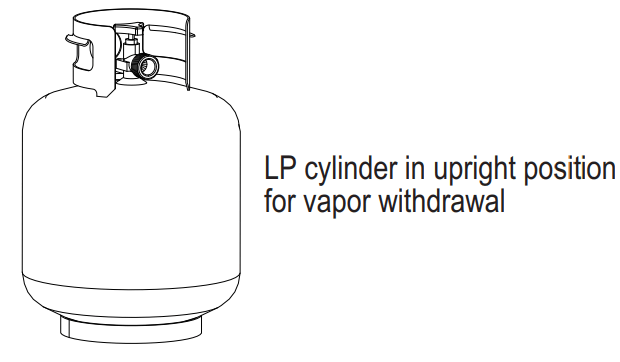
LP (Liquefied Petroleum Gas)
- LP gas is nontoxic, odorless and colorless when produced. For Your Safety, LP gas has been given an odor (similar to rotten cabbage) so that it can be smelled.
- LP gas is highly flammable and may ignite unexpectedly when mixed with air.
LP Cylinder Filling
- Use only licensed and experienced dealers.
- LP dealer must purge new cylinder before filling.
- Dealer should NEVER fill LP cylinder more than 80% of LP cylinder volume. Volume of propane in cylinder will vary by temperature.
- A frosty regulator indicates gas overfill. Immediately close LP cylinder valve and call local LP gas dealer for assistance.
- Do not release liquid propane (LP) gas into the atmosphere. This is a hazardous practice.
- To remove gas from LP cylinder, contact an LP dealer or call a local fire department for assistance. Check the telephone directory under “Gas Companies” for nearest certified LP dealers.
LP Cylinder Exchange
- Many retailers that sell grills offer you the option of replacing your empty LP cylinder through an exchange service. Use only those reputable exchange companies that inspect, precision fill, test and certify their cylinders. Exchange your cylinder only for an OPD safety feature-equipped cylinder as described in the "LP Cylinder" section of this manual.
- Always keep new and exchanged LP cylinders in upright position during use, transit or storage.
- Leak test new and exchanged LP cylinders BEFORE connecting to grill.
- Place safety cap on cylinder valve outlet whenever the cylinder is not in use. Only install the type of safety cap on the cylinder valve outlet that is provided with the cylinder valve. Other types of caps or plugs may result in leakage of propane.
LP Cylinder Leak Test
For your safety
- Leak test must be repeated each time LP cylinder is exchanged or refilled.
- Do not smoke during leak test.
- Do not use an open flame to check for gas leaks.
- Grill must be leak tested outdoors in a well-ventilated area, away from ignition sources such as gas fired or electrical appliances. During leak test, keep grill away from open flames or sparks.
- Use a clean paintbrush and a 50/50 mild soap and water solution. Brush soapy solution onto areas indicated by arrows in figure below.
- Do not use household cleaning agents. Damage to gas train components can result.
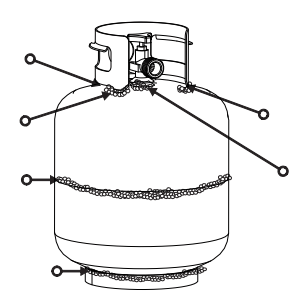
Connecting Regulator to the LP Cylinder
- LP cylinder must be properly secured onto grill. (Refer to assembly section.)
- Turn all control knobs to the OFF position
- Turn LP cylinder OFF by turning hand-wheel clockwise to a full stop.
- Remove the safety cap from LP cylinder valve. Always use cap and strap if supplied with valve.
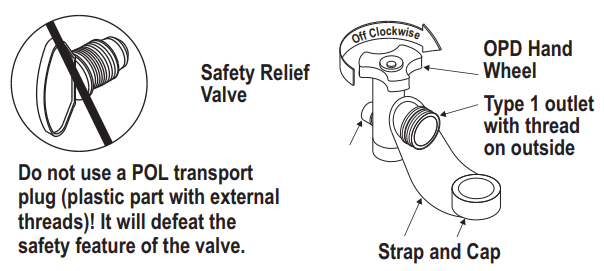
- Hold regulator and insert nipple into LP cylinder valve. Hand-tighten the coupling nut, holding regulator in a straight line with LP cylinder valve so as not to cross-thread the connection.

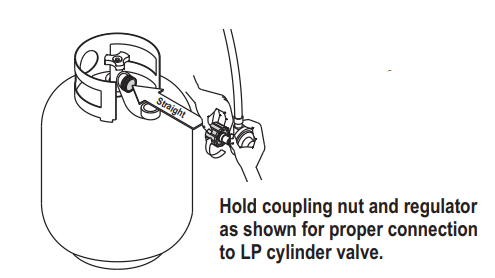
6. Turn the coupling nut clockwise and tighten to a full stop. The regulator will seal on the back-check feature in the LP cylinder valve, resulting in some resistance. An additional one-half to three-quarters turn is required to complete the connection. Tighten by hand only – do not use tools.
NOTE: If you cannot complete the connection, disconnect regulator and repeat steps 5 and 6. If you are still unable to complete the connection, do not use this regulator!
WARNING
• Do not use grill until leak-tested.
• If a leak is detected at any time, STOP! Turn off gas at source and correct leak.
• If you cannot stop a gas leak by closing the LP cylinder valve leave area and call your fire department!
Leak Testing Valves, Hose and Regulator
1. Turn all grill control knobs to OFF.
2. Be sure regulator is tightly connected to LP cylinder.
3. Completely open LP cylinder valve by turning hand wheel counterclockwise. If you hear a rushing sound, turn gas off immediately. There is a major leak at the connection. Correct before proceeding.
4. Brush soapy solution onto areas circled below, or other similar fittings on your grill.
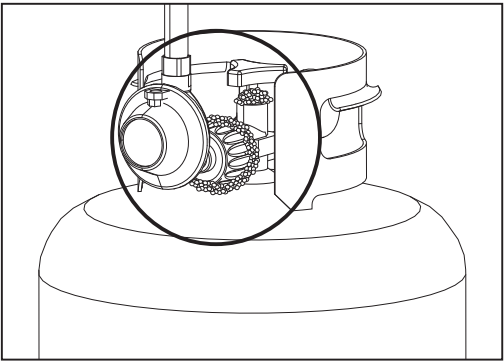
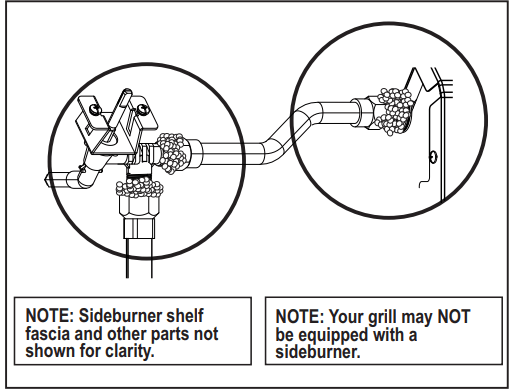
5.If “growing” bubbles appear, there is a leak. Close LP cylinder valve immediately and retighten connections. If leaks cannot be stopped do not try to repair. Call for replacement parts.
6.Always close LP cylinder valve after performing leak test by turning hand wheel clockwise.

For Safe Use of Your Grill and to Avoid Serious Injury:
• Do not let children operate or play near grill.
• Keep grill area clear and free from materials that burn.
• Do not block holes in sides or back of grill.
• Check burner flames regularly.
• Use grill only in well-ventilated space. NEVER use in enclosed space such as carport, garage, porch, covered patio, or under an overhead structure of any kind.
• Do not use charcoal or ceramic briquets in a gas grill.
• Do not cover grates with aluminum foil or any other material. This will block burner ventilation and create a potentially dangerous condition resulting in property damage and/or personal injury.
• Use grill at least 3 ft. from any wall or surface. Maintain 10 ft. clearance to objects that can catch fire or sources of ignition such as pilot lights on water heaters, live electrical appliances, etc.

• NEVER attempt to light or re-light burner with lid closed. A buildup of non-ignited gas inside a closed grill is hazardous.
• Never operate grill with LP cylinder out of correct position specified in assembly instructions.
• Always close LP cylinder valve and remove coupling nut before moving LP cylinder from specified operation position.
• Apartment Dwellers:
Check with management to learn the requirements and fire codes for using an LP gas grill in your apartment complex. If allowed, use outside on the ground floor with a three (3) foot clearance from walls or rails. Do not use on or under balconies.
Ignitor Lighting
• Do not lean over grill while lighting.
1. Turn gas burner control valves to O (off).
2. Open lid during lighting or re-lighting.
3. Turn ON gas at LP cylinder.
4. To ignite, push and turn IGNITION BURNER knob to  HIGH. Immediately, push and hold ELECTRONIC IGNITOR button until the burner lights.
HIGH. Immediately, push and hold ELECTRONIC IGNITOR button until the burner lights.
5. If ignition does NOT occur in 5 seconds, turn the burner controls off O , wait 5 minutes and repeat the lighting procedure.
6. To ignite remaining burners, push and turn knob to the  HIGH position starting with the burners closest to the IGNITION BURNER first.
HIGH position starting with the burners closest to the IGNITION BURNER first.
Match-Lighting
• Do not lean over grill while lighting.
1. Turn gas burner control valves to O (off).
2. Open lid during lighting or re-lighting.
3. Turn ON gas at LP cylinder.
4. Place match into match holder (hanging from side panel of grill). Light match; then light burner by placing match through the match light hole on side of grill. Immediately push in and turn burner knob to the  HIGH position. Be sure burner lights and stays lit.
HIGH position. Be sure burner lights and stays lit.
5. Light adjacent burners in sequence by pushing knobs in and turning to the  HIGH position.
HIGH position.
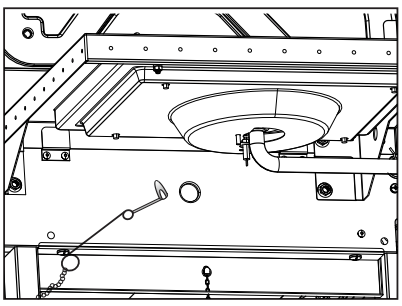
Burner Flame Check
• Remove cooking grates and heat tents. Light burners, rotate knobs from HIGH to LOW. You should see a smaller flame in LOW position than seen on HIGH. Perform burner flame check on side burner, also. Always check flame prior to each use. If only low flame is seen refer to "Sudden drop or low flame" in the Troubleshooting Section.

Turning Grill Off
• Turn all knobs to the O off position. Turn LP cylinder off by turning hand-wheel clockwise to a full stop.
Ignitor Check
• Turn gas off at LP cylinder. Press and hold electronic ignitor button. "Click" should be heard and spark seen each time in each collector box or between burner and electrode. See "Troubleshooting" if no click or spark.
Valve Check
• Important: Make sure gas is off at LP cylinder before checking valves. Knobs lock in off position. To check valves, first push in knobs and release, knobs should spring back. If knobs do not spring back, replace valve assembly before using grill. Turn knobs to LOW position then turn back to off position. Valves should turn smoothly.
Hose Check
• Before each use, check to see if hoses are cut or worn or kinked. Replace damaged hoses before using grill. Use only valve/hose/regulator specified by manufacturer.
Storing Your Grill
• Clean cooking grates.
• Store in dry location.
• When LP cylinder is connected to grill, store outdoors in a well-ventilated space and out of reach of children.
• Cover grill if stored outdoors. Choose from a variety of grill covers offered by Char-Broil at charbroil.com.
• Store grill indoors ONLY if LP cylinder is turned off and disconnected, removed from grill and stored outdoors.
• When removing grill from storage, follow “Cleaning the Burner Assembly” instructions before starting grill.
General Grill Cleaning
• Do not mistake brown or black accumulation of grease and smoke for paint. Interiors of gas grills are not painted at the factory (and should never be painted). Apply a strong solution of detergent and water or use a grill cleaner with scrub brush on insides of grill lid and bottom. Rinse and allow to completely air dry. Do not apply a caustic grill/oven cleaner to painted surfaces. 9
• Plastic parts: Wash with warm soapy water and wipe dry.
• Do not use citrisol, abrasive cleaners, degreasers or a
concentrated grill cleaner on plastic parts. Damage to and failure of parts can result.
• Porcelain surfaces: Because of glass-like composition, most residue can be wiped away with baking soda/water solution or specially formulated cleaner. Use nonabrasive scouring powder for stubborn stains.
• Painted surfaces: Wash with mild detergent or nonabrasive cleaner and warm soapy water. Wipe dry with a soft nonabrasive cloth.
• Stainless steel surfaces: To maintain your grill’s high quality appearance, wash with mild detergent and warm soapy water and wipe dry with a soft cloth after each use. Baked-on grease deposits may require the use of an abrasive plastic cleaning pad. Use only in direction of brushed finish to avoid damage. Do not use abrasive pad on areas with graphics.
• Cooking surfaces: If a bristle brush is used to clean any of the grill cooking surfaces, ensure no loose bristles remain on cooking surfaces prior to grilling. It is NOT recommended to clean cooking surfaces while grill is hot.
Cleaning the Burner Assembly
Follow these instructions to clean and/or replace parts of burner assembly or if you have trouble igniting grill.
1. Turn gas off at control knobs and LP cylinder.
2. Remove cooking grates and heat tents.
3. Remove carryover tubes and hardware securing burners.
4. Detach electrode from burner.
NOTE: Removal/Detachment method will depend on the burner configuration. See different configurations in illustrations below.
5. Carefully lift each burner up and away from valve openings. We suggest three ways to clean the burner tubes. Use the one easiest for you.
(A) Bend a stiff wire (a light weight coat hanger works well) into a small hook. Run the hook through each burner tube several times.

(B) Use a narrow bottle brush with a flexible handle (do not use a brass wire brush). Run the brush through each burner tube several times.
(C) Wear eye protection: Use an air hose to force air into the burner tube and out the burner ports. Check each port to make sure air comes out each hole.
6. Wire brush entire outer surface of burner to remove food residue and dirt.
7. Clean any blocked ports with a stiff wire such as an open paper clip.
8. Check burner for damage due to normal wear and corrosion, some holes may become enlarged. If any large cracks or holes are found, replace burner.
VERY IMPORTANT: Burner tubes must reengage valve openings. See illustrations at right.

9. Attach electrode to burner.
10. Carefully replace burners.
11. Attach burners to brackets on firebox.
12. Reposition carryover tubes and attach to burners. Replace heat tents and cooking grates.
13. Before cooking again on grill, perform a “Leak Test” and “Burner Flame Check”.

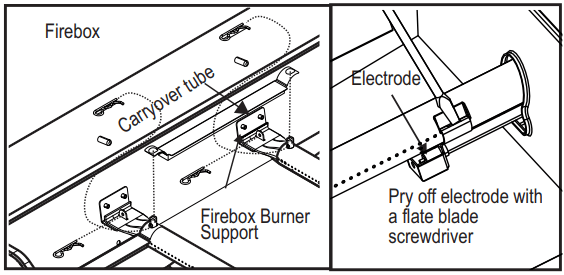
GRILLING GUIDE - Getting Started
First Time Use
Read your Assembly Manual and ensure the grill is put together properly. Remove all Point-of-Purchase advertising material from all grill surfaces before first use. We recommend operating your grill on its highest setting for 15-20 minutes prior to your first use. This aids in removing the oils used during manufacturing.
Lava Rock / Briquettes
This gas grill has been designed, engineered, and tested to be used with heat tents to provide more even heating, improve the cleaning process, and reduce flare-ups. The addition of after market lava rocks, charcoal, or briquettes of any type will cause poor combustion and increase the likelihood of a grease fire, and is not recommended. Using briquettes, lava rock, or charcoal in this grill will void your warranty. For extra smoke flavor, we recommend using a smoker box with wood chips.
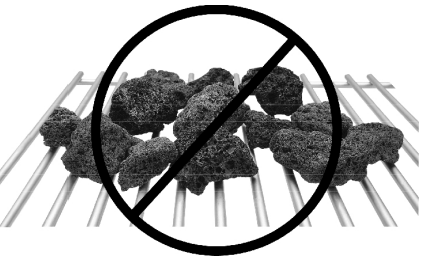
Temperature
The temperature gauge in the hood of your new grill is calibrated to give a close indication of the grate temperature.
Note: Since 1995, all regulators (the part that attaches to the gas tank to regulate the flow of gas) have included a safety feature that restricts gas flow in the event of a gas leak. You can inadvertently activate this safety feature without having a gas leak. This typically occurs when you turn on the gas using the grill control knob before you turn on the LP tank valve. If the gas regulator safety feature activates, the grill will only reach temperatures between 250°F and 300°F even with all burners on the high setting.
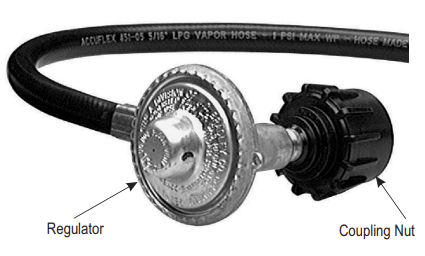
If your grill is not getting hotter than 250°F to 300°F these steps should be taken first to reset the gas regulator safety device:
1. Open the grill lid.
2. Turn off all knobs on the control panel in front.
3. Turn off the tank knob.
4. Disconnect the regulator from the LP tank.
5. Wait 30 seconds.
6. Reconnect the regulator to the LP tank.
7. Slowly open the LP tank knob all the way. Do not put excessive force on the valve at the full open position to avoid damaging the valve.
8. Turn on the appropriate control knob and light the grill per the instructions.
An illustration of this process is included in this Product Guide. See Troubleshooting section for additional information.
Pre-Heating Your Grill
Just like your home oven, your grill should be pre-heated to provide optimum performance. Pre-heat the grill on high for 1015 minutes - longer if weather conditions require. Please refer to the lighting instructions inside the Product Guide if you have questions about how to light your grill. A match-light chain and hole is provided for your convenience.
Outdoor grilling is really quite simple. You'll succeed with burgers, dogs, or steaks usually on your very first try. With experience, you will learn how to work with your grill, creating more imaginative meals all the time. This knowledge makes up the art of grilling. Before you start grilling, organize your food according to cooking technique and required cooking time, and optimize the use of your grilling area.
Direct Cooking
Direct cooking involves grilling your meat directly over high heat.
It is perfect for searing steaks, chops, and other smaller pieces of meat and vegetables that quickly make their way to the table.
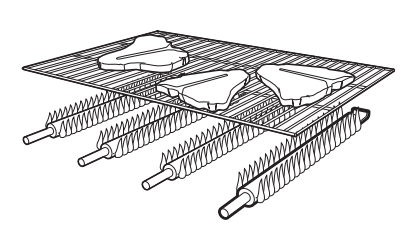
Indirect Cooking
Indirect cooking utilizes select burners to circulate heat throughout the grill, without direct contact between the meat and the flame. The meat is placed over the burner that is 'off. This method is generally used to slow cook large cuts of meat and poultry. A pan can be placed underneath the meat to catch grease and food drippings, and helps minimize clean-up.
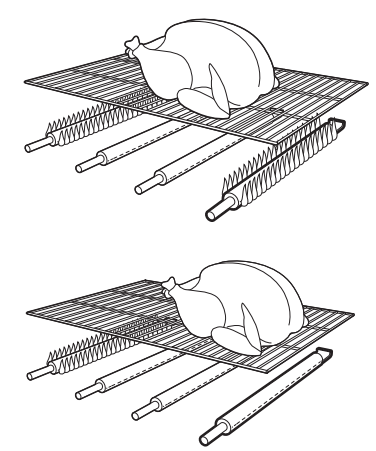
Rotisserie Cooking
Rotisserie cooking is best for 'round' meat, such as large roasts, whole poultry, and pork. It generally requires an accessory motor and spit rod that allows the meat to be turned at a constant speed. Rotisserie cooking is best done in front of a special rotisserie burner, or utilizing an indirect cooking burner arrangement. A pan can be placed underneath the meat to catch grease and food drippings, and helps minimize clean-up.
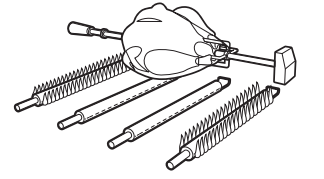
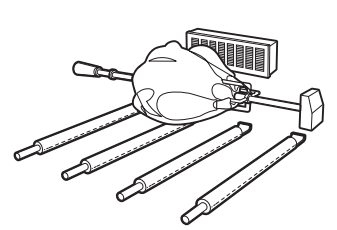
Food Safety
Food safety is a very important part of enjoying the outdoor cooking experience. To keep food safe from harmful bacteria, follow these four basic steps:
Clean: Wash hands, utensils, and surfaces with hot soapy water before and after handling raw meat.
Separate: Separate raw meats from ready-to-eat foods to avoid cross contamination. Use a clean platter and utensils when removing cooked foods.
Cook: Cook meat and poultry thoroughly to kill bacteria. Use a thermometer to ensure proper internal food temperatures.
Chill: Refrigerate prepared foods and leftovers promptly.
Cooking on your new grill is a hands-on experience, and it is recommended to remain outside with your grill while cooking. Grilling can be affected by many external conditions. In cold weather, you will need more heat to reach an ideal cooking temperature, and grilling may take longer. The meat's internal temperature and thickness can also affect cooking times. Cold and thicker meats will take longer to cook.
GRILLING GUIDE – Cleaning Your Grill
Why Clean?
We've all heard the saying 'An ounce of prevention is worth a pound of cure'. This is great advice when it comes to keeping your grill clean.
Routine Care
Periodic cleaning of this grill is necessary, as grill fires can occur when grease and food debris collect in the bottom of the grill. After each use, remove any remaining food particles from the cooking grate and inside of the grill using a grill brush. Do this after the grill has cooled down. This grill is not designed to be 'burned off' by closing the lid and turning the burners on High for an extended time. The excessive heat generated can cause leftover grease to catch fire, and can cause permanent damage to your grill.
General Cleaning
Plastic parts: Wash with warm soapy water and wipe dry. Do not use abrasive cleaners, degreasers or a concentrated grill cleaner on plastic parts. Damage to and failure of parts can result.
Porcelain surfaces: Because of glass-like composition, most residue can be wiped away with baking soda/water solution or glass cleaner. Use non-abrasive scouring powder for stubborn stains.
Painted surfaces: Wash with mild detergent or non-abrasive cleaner and warm water. Wipe dry with a soft non-abrasive cloth.
Stainless steel surfaces: Stainless steel can rust under certain conditions. This can be caused by environmental conditions such as chlorine or salt water, or improper cleaning tools such as wire or steel wool. It can also discolor due to heat, chemicals, or grease build-up. To maintain your grill's high quality appearance, wash with mild detergent and warm water, or use a stainless steel grill cleaner. Baked-on grease deposits may require the use of an abrasive plastic cleaning pad. Use only in direction of brushed finish to avoid damage. Do not use abrasive pad on areas with graphics.

Cooking surfaces: Ensure no loose bristles remain on cooking surfaces prior to grilling. It is not recommended to clean cooking surfaces while grill is hot.
Storing Your Grill
• Clean cooking grates.
• Store grill in dry location.
• When LP cylinder is connected to grill, store outdoors in a well ventilated space and out of reach of children.
• Cover grill if stored outdoors. Choose from a variety of grill covers offered by Char-Broil at charbroil.com.
• Store grill indoors ONLY if LP cylinder is turned off, disconnected, and removed from grill. Never store LP cylinder indoors.
• When removing grill from storage, follow the 'Cleaning the Burner Assembly' instructions in the Use and Care section of the Product Guide.
Critters
Spiders like to make their homes in the venturi tubes of grills. These must be inspected and cleaned regularly to ensure there are no blockages. Refer to the Use and Care portion of this Product Guide for complete information.
EMERGENCIES: If a gas leak cannot be stopped, or a fire occurs due to gas leakage, call the fire department.
Emergencies | Possible Cause | Prevention/Solution |
| Gas leaking from cracked/cut/burned hose. | • Damaged hose. | •Turn off gas at LP cylinder or at source on natural gas systems. Discontinue use of product and replace valve/hose/regulator. Once valve/hose/regulator replaced conduct complete leak check per manual. |
| Gas leaking from LP cylinder. | • Mechanical failure due to rusting or mishandling. | • Replace LP cylinder. |
| Gas leaking from LP cylinder valve. | • Failure of cylinder valve from mishandling or mechanical failure. | • Turn off LP cylinder valve. Return LP cylinder to gas supplier. |
| Gas leaking between LP cylinder and regulator connection. | • Improper installation, connection not tight, and/or failure of rubber seal in clyinder valve. | •Turn off LP cylinder valve. Remove regulator from cylinder and visually inspect rubber seal in cylinder valve for damage. If damage or cannot correct leak replace cylinder. See LP Cylinder Leak Test and Connecting Regulator to the LP Cylinder. |
| Fire coming through control panel. | • Fire in burner tube section of burner due to blockage. | • Turn off control knobs and LP cylinder valve. Leave lid open to allow flames to die down. After fire is out and grill is cold, remove burner and inspect for spider nests or rust. See Natural Hazard and Cleaning the Burner Assembly pages. |
| Grease fire or continuous excessive flames above cooking surface. | • Too much grease buildup in burner area | • Turn off control knobs and LP cylinder valve. Leave lid open to allow flames to die down. After cooling, clean food particles and excess grease from inside firebox area, grease tray, and other surfaces. |
Troubleshooting
Problem | Possible Cause | Prevention/Solution |
Burner(s) will not light using ignitor. (See Electronic Ignition Troubleshooting also) Continued on next page. | GAS ISSUES: • Trying to light wrong burner. | • See instructions on control panel and in Use and Care section. |
• Burner not engaged with control valve. | • Make sure valves are positioned inside of burner tubes. | |
• Obstruction in burner. | • Ensure burner tubes are not obstructed with spider webs or other matter. See cleaning section of Use and Care. | |
• No gas flow. | • Make sure LP cylinder is not empty. If LP cylinder is not empty, refer to “Sudden drop in gas flow.” | |
• Coupling nut and LP cylinder valve not fully connected. | • Turn the coupling nut approximately one-half to three-quarters additional turn until solid stop. Tighten by hand only - do not use tools. | |
ELECTRICAL ISSUES: |
| |
• Electrode cracked or broken; “sparks at crack.” | • Replace electrode(s). | |
• Electrode tip not in proper position. (Does not apply to SUREFIRE.) | Main Burners: • Tip of electrode should be pointing toward gas port opening on burner. The distance should be 1/8” to 1/4”. Adjust if necessary. Sideburner: | |
| • Tip of electrode should be pointing toward gas port opening on burner. the distance should be 1/8” to 3/16”. Adjust if necessary. | |
• Wire and/or electrode covered with cooking residue. | • Clean wire and/or electrode with rubbing alcohol and clean swab. | |
• Wires are loose or disconnected. | • Reconnect wires or replace electrode/wire assembly. | |
• Wires are shorting (sparking) between ignitor and electrode. | • Replace ignitor wire/electrode assembly. | |
• Dead battery. ELECTRONIC IGNITION: | • Replace with a new alkaline battery. | |
• No spark, no ignition noise. | • See Section I of Electronic Ignition System. | |
• No spark, some ignition noise. | • See Section II of Electronic Ignition System. | |
• Sparks, but not at electrode or at full strength. | • See Section III of Electronic Ignition System. | |
Burner(s) will not match light. | • See “GAS ISSUES:” . |
|
• Match will not reach. | • Use long-stem match (fireplace match). | |
• Improper method of match-lighting. | • See “Match-Lighting” section of Use and Care. |
Problem | Possible Cause | Prevention/Solution |
Sudden drop in gas flow or low flame. | • Out of gas. | • Check for gas in LP cylinder. |
| • Excess flow valve tripped. | • Turn off knobs, wait 30 seconds and light grill. If flames are still low, turn off knobs and LP cylinder valve. Disconnect regulator. Reconnect regulator and leak-test. Turn on LP cylinder valve, wait 30 seconds and then light grill. |
| • Vapor lock at coupling nut/LP cylinder connection. | • Turn off knobs and LP cylinder valve. Disconnect coupling nut from cylinder. Reconnect and retry. |
Flames blow out. | • High or gusting winds. | •Turn front of grill to face wind or increase flame height by turning gas valve to a higher postion. |
• Low on LP gas. | • Refill LP cylinder. | |
• Excess flow valve tripped. | • Refer to “Sudden drop in gas flow” above. | |
Flare-up. | • Grease buildup. | • Clean burners and inside of grill/firebox. |
• Excessive fat in meat. | • Trim fat from meat before grilling. | |
• Excessive cooking temperature. | • Adjust (lower) temperature accordingly. | |
Persistent grease fire. | • Grease trapped by food buildup around burner system. | • Turn knobs to OFF. Turn gas off at LP cylinder. Leave lid in position and let fire burn out. After grill cools, remove and clean all parts. |
Flashback (fire in burner tube(s)). | • Burner and/or burner tubes are blocked. | • Turn knobs to OFF. Clean burner and/or burner tubes. See burner cleaning section of Use and Care. |
One burner does not light from other burner(s). | • Grease buildup or food particles in end(s) of carryover tube(s). | • Clean carry-over tube(s) with wire brush. |
|
Troubleshooting - Electronic Ignition
Problem (Ignition) | Possible Cause | Check Procedure | Prevention/Solution |
SECTION I No sparks appear at any electrodes when Electronic Ignition Button is pressed; no noise can be heard from spark module. | • Battery not installed properly. • Dead battery. • Button assembly not installed properly. | • Check battery orientation. • Has battery been used previously? • Check to insure threads are properly engaged. Button should travel up and down without binding. | • Install battery (make sure that “+” and “-” connectors are oriented correctly, with “+” on cap end.) • Replace battery with new alkaline battery. • Unscrew button cap assembly and reinstall, making sure threads are aligned and engaged fully. |
| • Faulty spark module. | • If no sparks are generated with new battery and good wire connections, module is faulty. | • Replace spark module assembly. |
SECTION II No sparks appear at any electrodes when Electronic Ignition Button is pressed; noise can be heard from spark module. | • Output lead connections not connected. | • Are output connections on and tight? | • Remove and reconnect all output connections at module and electrodes. |
SECTION III Sparks are present but not at all electrodes and/or not at full strength | • Output lead connections not connected. • Arcing to grill away from burner(s). | • Are output connections on and tight? • If possible, observe grill in dark location. Operate ignition system and look for arcing between output wires and grill frame. | • Remove and reconnect all output connections at module and electrodes. • If sparks are observed other than from burner(s), wire insulation may be damaged. Replace wires. |
| • Weak battery. | • All sparks present but weak or at slow rate. | • Replace battery with a new alkaline battery. |
| • Electrodes are wet. | • Has moisture accumulated on electrode and/or in burner ports? | • Use paper towel to remove moisture. |
| • Electrodes cracked or broken “sparks at crack”. | • Inspect electrodes for cracks. | • Replace cracked or broken electrodes. |
PARTS DIAGRAM
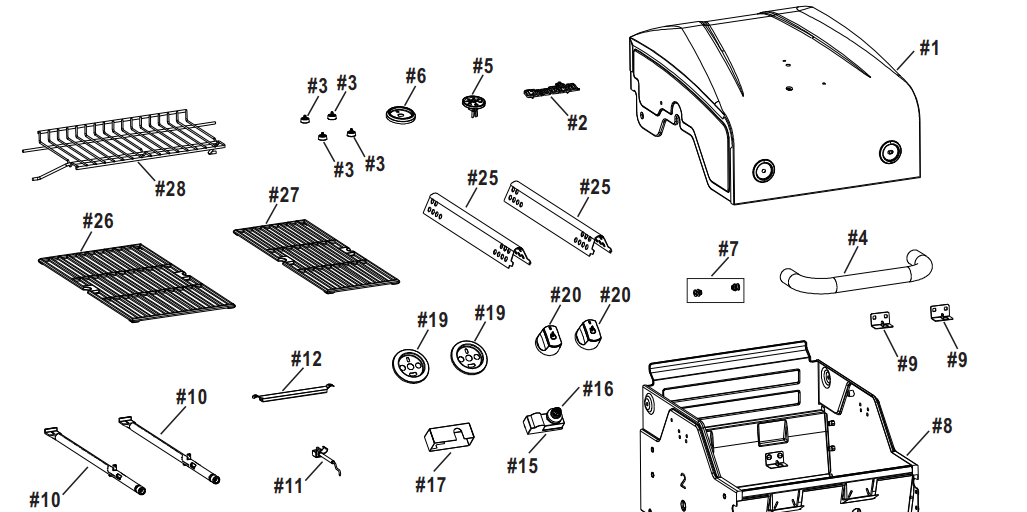
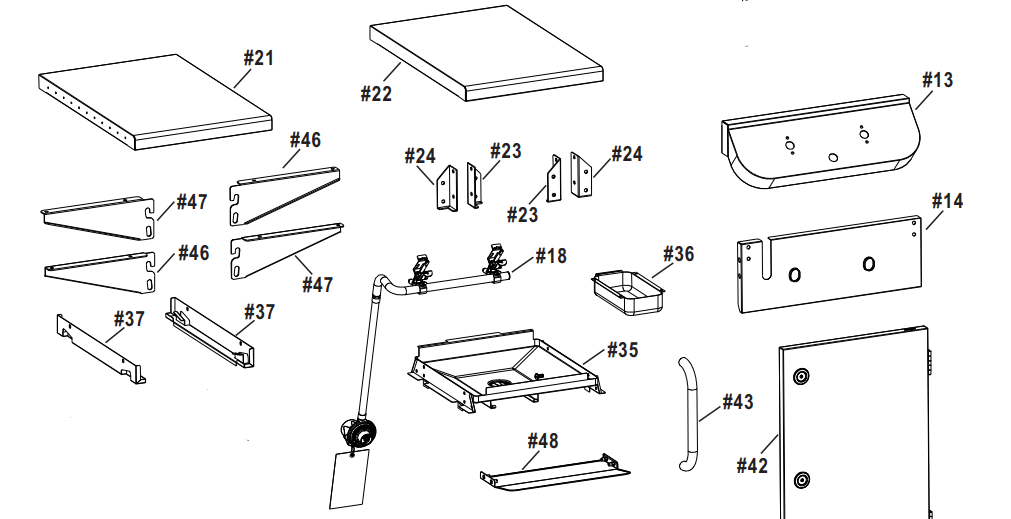
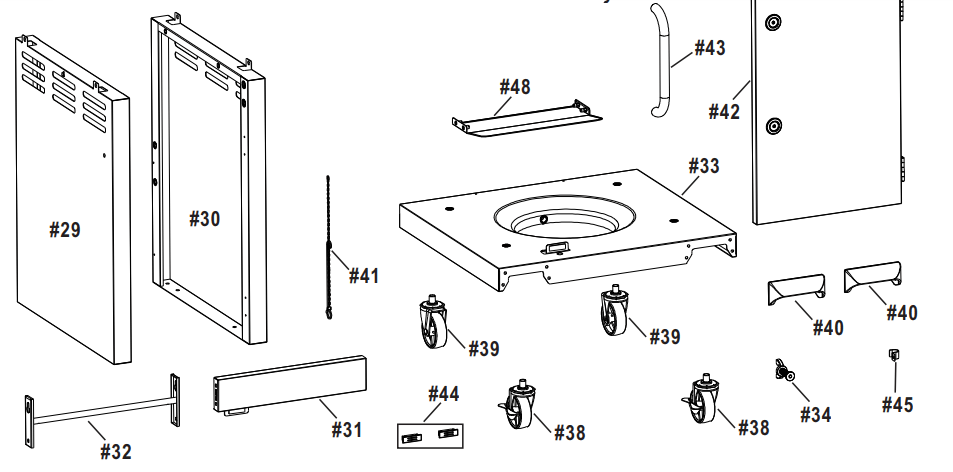
Key | Qty | Description |
1 | 1 | TOP LID |
2 | 1 | LOGO PLATE F/ LID |
3 | 4 | RUBBER BUMPER, W/ HOLE, F/ TOP LID |
4 | 1 | HANDLE F/ LID |
5 | 1 | THERMOMETER |
6 | 1 | BEZEL, F/ THERMOMETER |
7 | 1 | TOP LID HARDWARE |
8 | 1 | FIREBOX |
9 | 2 | BURNER BRACE |
10 | 2 | MAIN BURNER |
11 | 1 | ELECTRODE, F/ MAIN BURNER |
12 | 1 | CARRY OVER TUBE |
13 | 1 | CONTROL PANEL, MAIN |
14 | 1 | LOWER CONTROL PANEL |
15 | 1 | ELECTRONIC IGNITION MODULE |
16 | 1 | BUTTON, F/ IGNITION MODULE |
17 | 1 | SHIELD, F/ EI MODULE |
18 | 1 | HOSE VALVE REGULATOR ASSEM BLY |
19 | 2 | BEZEL F/ CONTROL KNOB |
20 | 2 | CONTROL KNOB |
21 | 1 | LEFT SIDE SHELF |
22 | 1 | RIGHT SIDE SHELF |
23 | 2 | SIDE SHELF BRACKET, RB/LF |
24 | 2 | SIDE SHELF BRACKET, LB/RF |
25 | 2 | HEAT TENT |
26 | 1 | COOKING GRATE |
27 | 1 | COOKING GRATE (NARROW) |
28 | 1 | SWINGAWAY RACK |
29 | 1 | LEFT, CART FRAME |
30 | 1 | RIGHT, CART FRAME |
31 | 1 | UPPER DOOR BRACE |
32 | 1 | BACK RAIL |
33 | 1 | BOTTOM SHELF |
34 | 1 | WING SCREW F/ TANK |
35 | 1 | GREASE TRAY |
36 | 1 | GREASE PAN |
37 | 2 | RAIL, F/ GREASE TRAY |
38 | 2 | CASTER, LOCKING |
39 | 2 | CASTER, FIXED |
Key | Qty | Description |
40 | 2 | CASTER FENDER |
41 | 1 | MATCH HOLDER |
42 | 1 | DOOR, NO HANDLE |
43 | 1 | DOOR HANDLE |
44 | 1 | MAGNET ASSEMBLY |
45 | 1 | REGULATOR HOSE CLIP |
46 | 2 | SHELF MOUNT, BRACKET, LF/RB |
47 | 2 | SHELF MOUNT, BRACKET, RF/LB |
48 | 1 | SHIELD, F/ TANK |
NOT Pictured
| 1 | CASTER PIN |
| 1 | PRODUCT GUIDE, ENGLISH, FRENCH, SPANISH |
| 1 | HARDWARE PACK |
